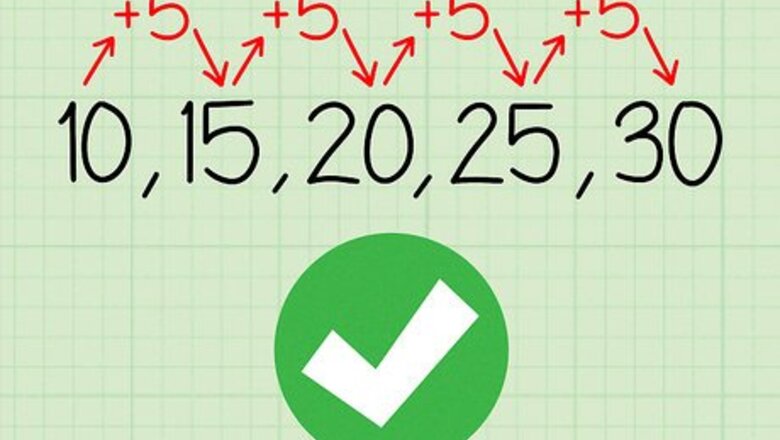
views
Assessing Your Sequence
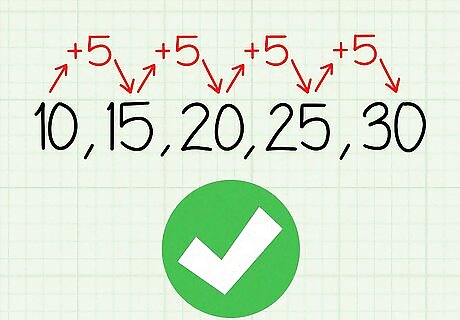
Make sure you have an arithmetic sequence. An arithmetic sequence is an ordered series of numbers, in which the change in numbers is constant. This method only works if your set of numbers is an arithmetic sequence. To determine whether you have an arithmetic sequence, find the difference between the first few and the last few numbers. Ensure that the difference is always the same. For example, the series 10, 15, 20, 25, 30 is an arithmetic sequence, because the difference between each term is constant (5).
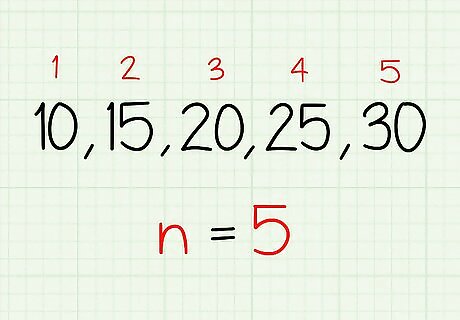
Identify the number of terms in your sequence. Each number is a term. If there are only a few terms listed, you can count them. Otherwise, if you know the first term, last term, and common difference (the difference between each term) you can use a formula to find the number of terms. Let this number be represented by the variable n {\displaystyle n} n. For example, if you are calculating the sum of the sequence 10, 15, 20, 25, 30, n = 5 {\displaystyle n=5} n=5, since there are 5 terms in the sequence.

Identify the first and last terms in the sequence. You need to know both of these numbers in order to calculate the sum of the arithmetic sequence. Often the first numbers will be 1, but not always. Let the variable a 1 {\displaystyle a_{1}} a_{{1}} equal the first term in the sequence, and a n {\displaystyle a_{n}} a_{{n}} equal the last term in the sequence. For example, in the sequence 10, 15, 20, 25, 30 a 1 = 10 {\displaystyle a_{1}=10} a_{{1}}=10, and a n = 30 {\displaystyle a_{n}=30} a_{{n}}=30.
Calculating the Sum
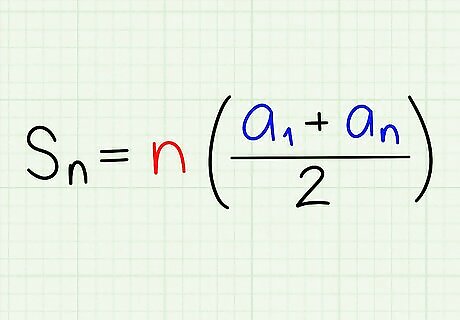
Set up the formula for finding the sum of an arithmetic sequence. The formula is S n = n ( a 1 + a n 2 ) {\displaystyle S_{n}=n({\frac {a_{1}+a_{n}}{2}})} S_{{n}}=n({\frac {a_{{1}}+a_{{n}}}{2}}), where S n {\displaystyle S_{n}} S_{{n}} equals the sum of the sequence. Note that this formula is indicating that the sum of the arithmetic sequence is equal to the average of the first and last term, multiplied by the number of terms.

Plug the values of n {\displaystyle n} n, a 1 {\displaystyle a_{1}} a_{{1}}, and a n {\displaystyle a_{n}} a_{{n}} into the formula. Make sure you make the correct substitutions. For example, if you have 5 terms in your sequence, and 10 is the first term, and 30 is the last term, your formula will look like this: S n = 5 ( 10 + 30 2 ) {\displaystyle S_{n}=5({\frac {10+30}{2}})} S_{{n}}=5({\frac {10+30}{2}}).

Calculate the average of the first and second term. To do this, add the two numbers, and divide by 2. For example: S n = 5 ( 40 2 ) {\displaystyle S_{n}=5({\frac {40}{2}})} S_{{n}}=5({\frac {40}{2}}) S n = 5 ( 20 ) {\displaystyle S_{n}=5(20)} S_{{n}}=5(20)
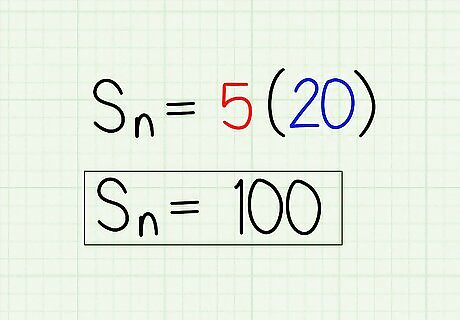
Multiply the average by the number of terms in the series. This will give you the sum of the arithmetic sequence. For example: S n = 5 ( 20 ) {\displaystyle S_{n}=5(20)} S_{{n}}=5(20) S n = 100 {\displaystyle S_{n}=100} S_{{n}}=100So, the sum of the sequence 10, 15, 20, 25, 30 is 100.
Completing Sample Problems
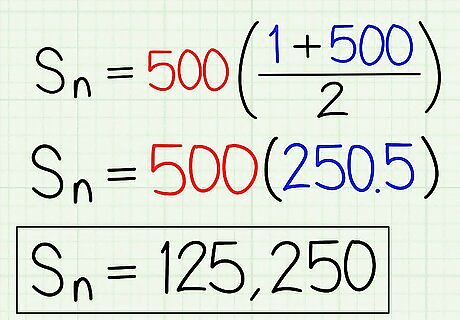
Find the sum of numbers between 1 and 500. Consider all consecutive integers. Determine the number of terms ( n {\displaystyle n} n) in the sequence. Since you are considering all consecutive integers to 500, n = 500 {\displaystyle n=500} n=500. Determine the first ( a 1 {\displaystyle a_{1}} a_{{1}}) and last ( a n {\displaystyle a_{n}} a_{{n}}) terms in the sequence. Since the sequence is 1 to 500, a 1 = 1 {\displaystyle a_{1}=1} a_{{1}}=1 and a n = 500 {\displaystyle a_{n}=500} a_{{n}}=500. Find the average of a 1 {\displaystyle a_{1}} a_{{1}} and a n {\displaystyle a_{n}} a_{{n}}: 1 + 500 2 = 250.5 {\displaystyle {\frac {1+500}{2}}=250.5} {\frac {1+500}{2}}=250.5. Multiply the average by n {\displaystyle n} n: 250.5 × 500 = 125 , 250 {\displaystyle 250.5\times 500=125,250} 250.5\times 500=125,250.
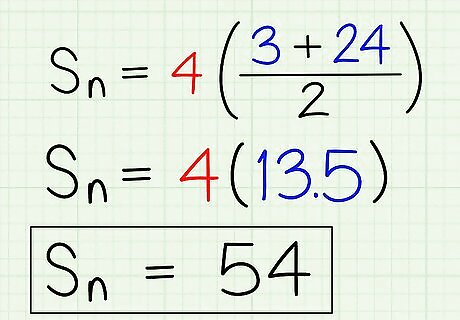
Find the sum of the described arithmetic sequence. The first term in the sequence is 3. The last term in the sequence is 24. The common difference is 7. Determine the number of terms ( n {\displaystyle n} n) in the sequence. Since you begin with 3, end with 24, and go up by 7 each time, the series is 3, 10, 17, 24. (The common difference is the difference between each term in the sequence.) This means that n = 4 {\displaystyle n=4} n=4 Determine the first ( a 1 {\displaystyle a_{1}} a_{{1}}) and last ( a n {\displaystyle a_{n}} a_{{n}}) terms in the sequence. Since the sequence is 3 to 24, a 1 = 3 {\displaystyle a_{1}=3} a_{{1}}=3 and a n = 24 {\displaystyle a_{n}=24} a_{{n}}=24. Find the average of a 1 {\displaystyle a_{1}} a_{{1}} and a n {\displaystyle a_{n}} a_{{n}}: 3 + 24 2 = 13.5 {\displaystyle {\frac {3+24}{2}}=13.5} {\frac {3+24}{2}}=13.5. Multiply the average by n {\displaystyle n} n: 13.5 × 4 = 54 {\displaystyle 13.5\times 4=54} 13.5\times 4=54.

Solve the following problem. Mara saves 5 dollars the first week of the year. For the rest of the year, she increases her weekly savings by 5 dollars every week. How much money does Mara save by the end of the year? Determine the number of terms ( n {\displaystyle n} n) in the sequence. Since Mara save for 52 weeks (1 year), n = 52 {\displaystyle n=52} n=52. Determine the first ( a 1 {\displaystyle a_{1}} a_{{1}}) and last ( a n {\displaystyle a_{n}} a_{{n}}) terms in the sequence. The first amount she saves is 5 dollars, so a 1 = 5 {\displaystyle a_{1}=5} a_{{1}}=5. To find out the amount she saves the last week of the year, calculate 5 × 52 = 260 {\displaystyle 5\times 52=260} 5\times 52=260. So a n = 260 {\displaystyle a_{n}=260} a_{{n}}=260. Find the average of a 1 {\displaystyle a_{1}} a_{{1}} and a n {\displaystyle a_{n}} a_{{n}}: 5 + 260 2 = 132.5 {\displaystyle {\frac {5+260}{2}}=132.5} {\frac {5+260}{2}}=132.5. Multiply the average by n {\displaystyle n} n: 132.5 × 52 = 6 , 890 {\displaystyle 132.5\times 52=6,890} {\displaystyle 132.5\times 52=6,890}. So she saves $6,890 by the end of the year.



















Comments
0 comment